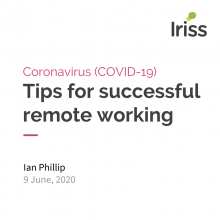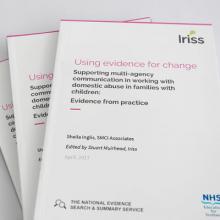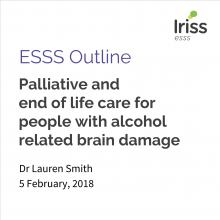Introduction
This summary provides an overview of recent evidence concerning:
Difficult conversations happening during COVID-19.
About the evidence presented below
The summary below considers the developing evidence on having difficult conversations during the COVID-19 pandemic. It gives specific consideration to conversations around end-of-life care and to talking to children about COVID-19. This summary reflects mostly on evidence published in the past months which are specifically addressing the unique health and social care needs of this time.
It is reassuring to see that evidence and guidelines are being published and updated to reflect how services are responding to the crisis. Nonetheless, as the situation is developing, there is little for scope for a wider reflection and comparisons between sources of evidence.
Difficult conversations around end-of-life care during COVID-19
The current COVID-19 crisis has presented many exceptional challenges to health and social care provision. Recently, health and social care settings like GPs and care homes have come under national scrutiny (Scottish Parliament, 2020) for how they approach difficult conversations about end-of-life care, death and dying. Health and social care guidelines highlight that these discussions are important to ensure the best quality of care for individuals and to minimise physical, emotional and psychological harm to individuals and their families (Effective Communication for Healthcare, 2020; Clarke 2020). These conversations, challenging in themselves in normal circumstances, are compounded by the sense of urgency we are experiencing during this crisis.
At times, the manner in which difficult conversations are taking place (BBC, 2020) has led to a sense of widespread confusion and concern among individuals and their families. Much of this concern surrounds conversations around CPR and Do Not Resuscitate procedures which are seen by some as an attempt to “ration” care (Clarke 2020). The Care Quality Commission and other medical bodies are also concerned about the blanket application of Do Not Resuscitate notices (Booth 2020; Care Quality Commission, 2020).
Clarke (2020) argues that if practitioners are broaching discussion around CPR or DNRs with individuals, they are doing so not to “ration” care but rather to ensure individuals are not “unknowingly subjected to a futile and inappropriate treatment”.
Curtis et al (2020) argue that now is the time to implement advance care planning to ensure individuals do not receive care they would not want if they become too severely ill to make their own decisions. Patients with chronic life-limiting illness should be offered the option if they would not want to receive cardiopulmonary resuscitation (CPR) or mechanical ventilation (Curtis et al 2020).
Nonetheless, Curtis et al (2020) acknowledge that these decisions are also considered from “the potential need for rationing health care in the context of scarce resources and crisis capacity”. A ‘rationing’ perspective has moral and ethical ramifications that can negatively affect individuals who are faced with these decisions. This has led individuals to feel ‘worthless’ and distressed (BBC, 2020). To avoid these shortfalls, Ferguson et al (2020) urge staff and clinicians to have advance care planning discussions in order to provide person-centred, medically appropriate care.
Advance care planning
Conversations surrounding end of life care are often a small element of advance care planning. Advance or anticipatory care planning is a multi-dimensional approach to planning the care of individuals, often in palliative care:
“Anticipatory Care Planning (ACP) is a person-centred, proactive, ‘thinking ahead’ approach, with health and care professionals working with individuals, carers and their families to make informed choices about their care and support. [...] ACP enables individuals with chronic and complex conditions to understand their current health and wellbeing, whilst anticipating and proactively managing their health and care needs. Optimal outcomes and improving quality of life through ACP are helped by early intervention when people have complex needs or changing circumstances” (Edinburgh HSCP (2019, p5).
The Scottish Partnership for Palliative Care (2020) have built a pool of resources on Anticipatory and palliative Care Planning. In light of the ongoing COVID-19 crisis they have augmented this collection with further resources on difficult conversation, staff stress resilience and care homes. As seen in the resources themselves, these three additions are interlinked. They highlight that many difficult conversations around end of life care are happening in care homes and are often a source of distress among staff themselves.
The Scottish Partnership for Palliative Care has also produced an updated COVID-19 ACP (2020) which is a template to be used by staff to manage challenging conversation. This template also references Edinburgh HSCP’s REDMAP tool (2020) which provides detailed steps to frontline staff on ACP and end of life conversations. The template highlights the need to ask individuals about those things that are important to them when it comes to their care. Crucially, these tools and resources were developed over several years and include the perspectives of different stakeholders like families, care users, care homes and medical staff. This gives these guidelines a strong evidence base.
Person-centred conversations
Many guidelines like Ferguson et al’s (2020) Edinburgh HSCP (2020) Redmap Tool and Curtis et al’s (2020) highlight that when approaching end of life conversations, it is important to prioritise goal concordant or value focused and person-centred care.
Waikato District Health Board (2020) has also published its guidelines for palliative care and they argue that it is important to identify realistic goals of care, and support families to contribute to decision-making, whilst also helping them deal with their own distress.
Fergus et al (2020) suggest that long-term care facilities like care homes or medical wards should provide as much psychosocial care and support as feasible in this challenging time. Use of social media and video phone call options may also be useful for some patients/residents in order to facilitate interaction with family and friends. They also stress the importance of providing grief counselling for families and also staff (Fergus et al 2020). Consideration should be given to modifying visitor restrictions to allow family and friends to comfort their loved ones who are at the end of life.
Predominantly evidence so far like Ferguson et al (2020), Fausto et al (2020), Curtis et al (2020) and Waikato District Health Board (2020) refers mostly to guidelines and recommendations of practice – what practitioners should do in certain circumstances. Moreover, it is focused on clinical settings – this is understandable to some extent. However, as seen recently, these conversations are also taking place in care homes or in the community and there is less guidance for these settings. Many of these resources do not consider how staff can manage these difficult conversations in a more practical way that reflects the realities and emotions involved around end of life and palliative care. Apart from the formality of these conversations, the manner in which they are carried has immense implications for the wellbeing of individuals. Below details some of the evidence that covers these important aspects of difficult conversations.
Some of the resources produced by The Scottish Partnership for Palliative Care (2020) give a realist and compassionate reflection on how front line staff can manage these difficult conversations. One of these is a short, accessible video (Mitchell 2020).
She acknowledges that currently, these conversations are developing with a sense of urgency as seen in care homes across the country which compounds both the stress experienced by staff and the distress experienced by those with care needs.
Mitchell (2020) highlights how the current level of isolation for individuals in a care setting can be a new and distressing challenge for front line staff themselves: “I think we struggle with the concept of caring for the dying, and providing a good death for someone is equally as important”. She stresses the importance of:
- Openness
- Compassion
- Dignity (Mitchell 2020)
Mitchell is honest about the challenges frontline staff themselves might experience in approaching this topic and provides practical guidelines for how to do this, emphasising the need to listen to individuals receiving care.
She reflects on the language that is appropriate and useful in these circumstances and encourages frontline staff to debrief with their peers (Mitchell 2020).
Health Education England (n.a) also has an online learning tool aimed at developing the communication skills of staff working in end of life care. This module encourages reflection and recommends similar principles as Mitchel (2020).
The guidelines discussed above highlight several key issues and challenges when it comes to difficult conversations:
- They all highlight the importance of person-centred care and of including the families in these difficult conversations
- Supporting families with bereavement and counselling is also highlighted as a key goal
- Mitchell (2020) also stresses the importance of openness and compassion
- She also highlights the importance for staff themselves to debrief and process these conversations (Mitchell 2020).
More evidence is needed to understand the practical challenges of these conversations and to uncover ways to manage them.
Talking to children about COVID-19
Many frontline staff will have to support children during this crisis – both in their professional role but also in their personal life.
Below is a short summary on the current evidence and recommendations for talking to children and adolescents about COVID-19.
It is increasingly clear that children are currently being exposed to large amounts of information and high stress and anxiety in their parents or carers. During this time, children can also often suddenly lose essential resilience resources, like the support of parents, friends, neighbours and the social infrastructure that is normally in place to ensure their safety (UNICEF, 2020). They might be experiencing radical changes in their daily lives and social infrastructure. This poses challenges as emergencies and traumatic events like COVID-19 can lead to mental health issues in children and adolescents (Danese et al 2019).
Dalton et al (2020) argue that consideration of the child’s developmental stage is essential and conversations must also take into account children's comprehension of illness and causality. This is necessary to ensure that children are not blaming themselves.
Listening to what children believe is important as well as providing them with an explanation that is meaningful to them. Research shows that parents often do not reflect on their own emotions and focus instead on technicalities and practicalities of a situation (Dalton 2020). Adults need to be authentic about some of the uncertainty and psychological challenges of the pandemic. By being honest, this offers children a coherent narrative for what they are observing, and also grants permission for children to safely talk about their own feelings.
Mercy Corps (2020) has also recently produced a ten-step guideline for talking to children about COVID-19. They recommend:
- Being aware of common reactions like becoming more quiet or withdrawn
- Dealing with fears and worries – realising that common childhood fears may intensify after a crisis
- Creating a sense of safety
- Limiting exposure to news
- Listen to children’s worries
- Encouraging writing or drawing about their experience
- Playing
- Modelling healthy coping skills – adults should process what they’re going through privately so they have the resources to support children.
- Monitor behaviour over time
- Inspire a positive response like volunteering and supporting the local community.
Moore and Rauch (2015) have also produced resources for talking to children following crises and disasters. Their advice echoes those above, but they also advise thinking together with the child about a plan to cope with and actively manage anxiety. This could include a strategy to manage physical symptoms, a helpful self-help statement and a plan for facing fears.
Children should not be encouraged to avoid situations that trigger anxiety. Even though avoiding certain situations or “triggers” to anxiety may help children feel calmer in the short run, in the long run, avoidance actually increases anxiety.
They suggest finding ways to communicate fears that do not involve talking, as well as identifying any specific worries that children can put into words (Moore and Rauch 2015).
Importantly, they highlight that even when it is not possible to assure children that things are 100% safe, adults should give concrete examples of how caregivers, teachers, police, doctors, and others are working together to make things safe for them and their community (Moore and Rauch 2015).
References
BBC (2020) Coronavirus: GP surgery apology over 'do not resuscitate' form, Available at: https://www.bbc.co.uk/news/uk-wales-52117814
Booth R (2020) UK healthcare regulator brands resuscitation strategy unacceptable, Available at: https://www.theguardian.com/world/2020/apr/01/uk-healthcare-regulator-brands-resuscitation-strategy-unacceptable
Clarke R (2020) 'Do not resuscitate' orders have caused panic in the UK. Here is the truth, Available at: https://www.theguardian.com/commentisfree/2020/apr/08/do-not-resuscitate-orders-caused-panic-uk-truth#_=_
COVID-19: Effective communication for professionals (2020), Effective Communication For Healthcare https://www.ec4h.org.uk/covid-19-effective-communication-for-professionals/
Curtis JR Kross EK Stapleton RD (2020) The Importance of Addressing Advance Care Planning and Decisions About Do-Not-Resuscitate Orders During Novel Coronavirus 2019 (COVID-19). JAMA. Published online March 27, 2020 https://jamanetwork.com/journals/jama/article-abstract/2763952
Dalton L, Rapa E, Stein A (2020) Protecting the psychological health of children through effective communication about COVID-19, Lancet Child and Adolescent Health 2020, Published Online March 31, 2020 https://www.thelancet.com/journals/lanchi/article/PIIS2352-4642(20)30097-3/fulltext
Danese A, Smith P, Chitsabesan P, Dubicka B (2019) Child and adolescent mental health amidst emergencies and disasters,The British Journal of Psychiatry (2020) 216, 159–162. doi: 10.1192/bjp.2019.244 https://www.cambridge.org/core/services/aop-cambridge-core/content/view/C112839620C6AF501E8927F994EA228C/S0007125019002447a.pdf/child_and_adolescent_mental_health_amidst_emergencies_and_disasters.pdf
European Association for Palliative Care (2020) Coronavirus and the palliative care response https://www.eapcnet.eu/publications/coronavirus-and-the-palliative-care-response
Fausto J, Hirano L, Lam D, Mehta A, Mills B, Owens D, Perry E,Curtis JR (2020), Creating a Palliative Care Inpatient Response Plan for COVID19 – The UW Medicine Experience, Journal of Pain and Symptom Management https://doi.org/10.1016/j.jpainsymman.2020.03.025
Ferguson L, Barham D (2020) Palliative Care Pandemic Pack: a Specialist Palliative Care Service response to planning the COVID-19 pandemic, Journal of Pain and Symptom Management https://doi.org/10.1016/j.jpainsymman.2020.03.026
Health Education England, Online Course – End of life care for all https://portal.e-lfh.org.uk/Component/Details/502617
Mitchell L (2020) Difficult Conversations – we need to talk about dying, Advice for health and care professionals, Video https://vimeo.com/404554818
Moore C W & Rauch P K (2015) Community Crises and Disasters A Parent’s Guide to Talking with Children of All Ages, A Project of The Marjorie E. Korff Parenting At a Challenging Time Program Massachusetts General Hospital https://www.mghpact.org/assets/media/documents/MGH%20PACT%20Guide%20(Talking).pdf
Scottish Parliament (2020) Virtual Question Time https://www.scottishparliament.tv/meeting/leaders-virtual-question-time-april-9-2020
Scottish Partnership for Palliative Care (2020) COVID-19: Palliative and EOLC resources https://www.palliativecarescotland.org.uk/content/covid-scottish-eolc-guidance
Talking with people and families about planning care, death and dying (2020) https://www.ec4h.org.uk/wp-content/uploads/2020/04/RED-MAP-Guide-for-Professionals-V5.0-080420.pdf
UNICEF (2020) How to talk to your child about coronavirus disease 2019 (COVID-19) https://www.unicef.org/coronavirus/how-talk-your-child-about-coronavirus-covid-19
Waikato District Health Board (2016) Waikato Palliative Care Strategic Plan 2016 - 2021 https://waikatodhb.cwp.govt.nz/assets/Docs/About-Us/Key-Publications/Plans/5625f7ceb7/Waikato-DHB-Palliative-Care-Strategic-Plan-2016-21.pdf
Waikato District Health Board (2020) “Te Ara Whakapiri” – Care in the last days of life https://www.hospicewaikato.org.nz/file/te-ara-whakapiri-care-plan-inpatient-and-residential-care/open
Accessing resources
We have provided links to the materials referenced in the summary. Some materials are paywalled, which means they are published in academic journals and are only available with a subscription. Some of these are available through the The Knowledge Network with an NHS Scotland OpenAthens username. The Knowledge Network offers accounts to everyone who helps provide health and social care in Scotland in conjunction with the NHS and Scottish Local Authorities, including many in the third and independent sectors. You can register here. Where resources are identified as ‘available through document delivery’, these have been provided to the original enquirer and may be requested through NHS Scotland’s fetch item service (subject to eligibility).
Where possible we identify where evidence is published open access, which means the author has chosen to publish their work in a way that makes it freely available to the public. Some are identified as author repository copies, manuscripts, or other copies, which means the author has made a version of the otherwise paywalled publication available to the public. Other referenced sources are pdfs and websites that are available publicly.
Suggested reference: Bocioaga A (2020) Difficult Conversations during COVID-19. Iriss doi: 10.31583/esss.20200424








